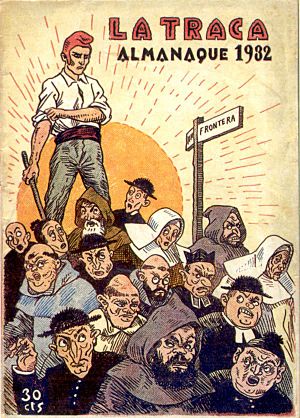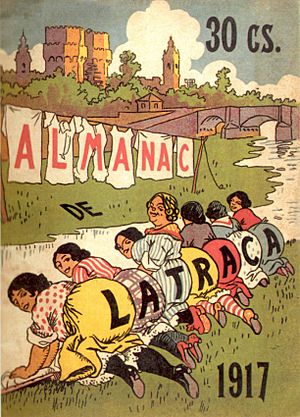La Traca facts for kids

Cover page dated 1932
|
|
| Categories | Satirical magazine |
|---|---|
| Frequency | Weekly |
| Founder |
|
| Founded | 1884 |
| Final issue | 1939 |
| Country | Spain |
| Based in | Valencia |
| Language | |
La Traca (which means The Firecracker in Spanish) was a fun and witty weekly magazine. It was published in Valencia, Spain. This magazine was very popular. It sold an amazing half a million copies! This made it the first satirical magazine in Spain to reach such a huge number of readers.
Contents
What Was La Traca?
La Traca was a magazine that used humor to make fun of things. It often made jokes about politics and society. It was known for its funny drawings called caricatures. The magazine was published weekly, meaning it came out every week.
How La Traca Started
La Traca first started in 1884. It was created by two people: Manuel Lluch Soler and Luis Cebrian Mezquita. The magazine was based in Valencia. It supported a republican way of thinking. This means it preferred a government led by an elected president, not a king or queen. The magazine stopped being published in 1892.
La Traca's Comeback
But La Traca came back! Vicente Miguel Carceller restarted it in 1909. The magazine often faced censorship. This means people in power tried to stop it from publishing certain things. This was especially true if the magazine made fun of them.
Facing Challenges: Censorship and Closure
La Traca was finally closed for good in 1939. This happened because it published funny drawings of Francisco Franco. He was a powerful leader at the time. The magazine's editor, Vicente Miguel Carceller, was arrested. He sadly lost his life because he was against Franco's ideas.
What Was Inside La Traca?
At first, La Traca used the Valencian dialect. This is a special way of speaking Spanish in Valencia. In 1931, the magazine switched to the Spanish language. After this change, it became even more popular. It sold over 500,000 copies!
One of the artists who worked for La Traca was Gaspar Méndez Álvarez. He drew many pictures and wrote funny articles. His work often made fun of religious leaders and politics. He started contributing to the magazine in 1928.
See also
 In Spanish: La Traca para niños
In Spanish: La Traca para niños


